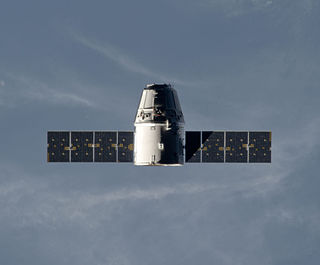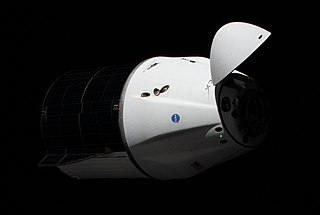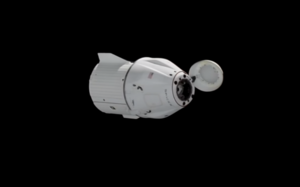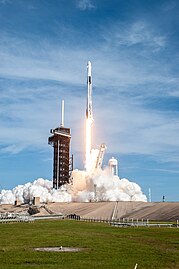
SpaceX CRS-1, also known as SpX-1, was SpaceX's first operational cargo mission to the International Space Station, under their Commercial Resupply Services (CRS-1) contract with NASA. It was the third flight for the uncrewed Dragon cargo spacecraft, and the fourth overall flight for the company's two-stage Falcon 9 launch vehicle. The launch occurred on 8 October 2012 at 00:34:07 UTC.

Orbital-1, also known as Orb-1, was the second flight of the Orbital Sciences Cygnus cargo spacecraft, its second flight to the International Space Station (ISS) and the third launch of the company's Antares launch vehicle. The mission launched on 9 January 2014 at 18:07:05 UTC.

SpaceX CRS-4, also known as SpX-4, was a Commercial Resupply Service mission to the International Space Station (ISS), contracted to NASA, which was launched on 21 September 2014 and arrived at the space station on 23 September 2014. It was the sixth flight for SpaceX's uncrewed Dragon cargo spacecraft, and the fourth SpaceX operational mission contracted to NASA under a Commercial Resupply Services contract. The mission brought equipment and supplies to the space station, including the first 3D printer to be tested in space, a device to measure wind speed on Earth, and small satellites to be launched from the station. It also brought 20 mice for long-term research aboard the ISS.

Nanoracks LLC is a private in-space services company which builds space hardware and in-space repurposing tools. The company also facilitates experiments and launches of CubeSats to Low Earth Orbit.

SpaceX CRS-6, also known as SpX-6, was a Commercial Resupply Service mission to the International Space Station, contracted to NASA. It was the eighth flight for SpaceX's uncrewed Dragon cargo spacecraft and the sixth SpaceX operational mission contracted to NASA under a Commercial Resupply Services contract. It was docked to the International Space Station from 17 April to 21 May 2015.

SpaceX CRS-10, also known as SpX-10, was a Dragon Commercial Resupply Service mission to the International Space Station (ISS) which launched on 19 February 2017. The mission was contracted by NASA as part of its Commercial Resupply Services program and was launched by SpaceX aboard the 30th flight of the Falcon 9 rocket. The mission ended on 19 March 2017 when the Dragon spacecraft left the ISS and safely returned to Earth.

SpaceX CRS-11, also known as SpX-11, was a Commercial Resupply Service mission to the International Space Station, launched successfully on 3 June 2017. The mission was contracted by NASA and was flown by SpaceX. The mission utilized a Falcon 9 launch vehicle and was the first reuse of C106, a CRS Dragon cargo vessel that was previously flown on the CRS-4 mission.

SpaceX CRS-12, also known as SpX-12, was a Commercial Resupply Services mission to the International Space Station launched on 14 August 2017. The mission was contracted by NASA and was flown by SpaceX using a new Dragon capsule. The Falcon 9 rocket's reusable first stage performed a controlled landing on Landing Zone 1 (LZ1) at Cape Canaveral Air Force Station. After delivering more than 2,900 kilograms (6,400 lb) of cargo, the Dragon spacecraft returned to Earth on 17 September 2017.

SpaceX CRS-13, also known as SpX-13, was a Commercial Resupply Service mission to the International Space Station launched on 15 December 2017. The mission was contracted by NASA and is flown by SpaceX. It was the second mission to successfully reuse a Dragon capsule, previously flown on CRS-6. The first stage of the Falcon 9 Full Thrust rocket was the previously flown, "flight-proven" core from CRS-11. The first stage returned to land at Cape Canaveral's Landing Zone 1 after separation of the first and second stage.

SpaceX CRS-14, also known as SpX-14, was a Commercial Resupply Service mission to the International Space Station launched on 2 April 2018. The mission was contracted by NASA and was flown by SpaceX. This mission reused the Falcon 9 first stage booster previously flown on CRS-12 and the Dragon capsule flown on CRS-8.

SpaceX CRS-15, also known as SpX-15, was a Commercial Resupply Service mission to the International Space Station launched 29 June 2018 aboard a Falcon 9 rocket. The mission was contracted by NASA and flown by SpaceX.

OA-9E was the tenth flight of the Orbital ATK uncrewed resupply spacecraft Cygnus and its ninth flight to the International Space Station (ISS) under the Commercial Resupply Services with NASA. The mission launched on 21 May 2018 at 08:44:06 UTC. Orbital ATK and NASA jointly developed a new space transportation system to provide commercial cargo resupply services to the International Space Station. Under the Commercial Orbital Transportation Services (COTS) program, then Orbital Sciences designed and built Antares, a medium-class launch vehicle; Cygnus, an advanced maneuvering spacecraft, and a Pressurized Cargo Module which is provided by Orbital's industrial partner Thales Alenia Space.

SpaceX CRS-16, also known as SpX-16, was a Commercial Resupply Service mission to the International Space Station launched on 5 December 2018 aboard a Falcon 9 launch vehicle. The mission was contracted by NASA and is flown by SpaceX.

SpaceX CRS-18, also known as SpX-18, was SpaceX's 18th flight to the International Space Station under the Commercial Resupply Services program for NASA. It was launched on 25 July 2019 aboard a Falcon 9 rocket.

SpaceX CRS-19, also known as SpX-19, was a Commercial Resupply Service mission to the International Space Station. The mission is contracted by NASA and was flown by SpaceX on a Falcon 9 rocket.

Dragon, also known as Dragon 1 or Cargo Dragon, was a class of fourteen partially reusable cargo spacecraft developed by SpaceX, an American private space transportation company. The spacecraft flew 23 missions between 2010 and 2020. Dragon was launched into orbit by the company's Falcon 9 launch vehicle to resupply the International Space Station (ISS).

SpaceX CRS-22, also known as SpX-22, was a Commercial Resupply Services (CRS) mission to the International Space Station (ISS) that launched at 17:29:15 UTC on 3 June 2021. The mission is contracted by NASA and is flown by SpaceX using a Cargo Dragon 2. This is the second flight for SpaceX under NASA's CRS Phase 2 contract awarded in January 2016.

SpaceX CRS-23, also known as SpX-23, was a Commercial Resupply Service mission to the International Space Station, successfully launched on 29 August 2021 and docking the following day. The mission was contracted by NASA and was flown by SpaceX using the Cargo Dragon C208. This was the third flight for SpaceX under NASA's CRS Phase 2 contract awarded in January 2016. It was the second mission for this reusable capsule.

SpaceX CRS-24, also known as SpX-24, was a Commercial Resupply Service mission to the International Space Station launched on 21 December 2021, at 10:07:08 UTC. The mission is contracted by NASA and is flown by SpaceX using a Cargo Dragon. This is the fourth flight for SpaceX under NASA's CRS Phase 2 contract awarded in January 2016.

SpaceX CRS-28, also known as SpX-28, is a Commercial Resupply Service mission to the International Space Station (ISS) launched on 5 June 2023. The mission was contracted by NASA and flown by SpaceX using Cargo Dragon C208. It was the eighth flight for SpaceX under NASA's CRS Phase 2.






























